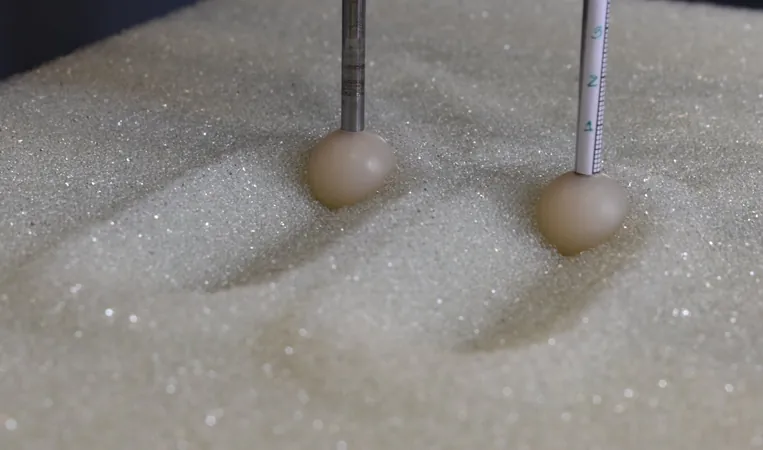
Revolutionary Discoveries in Granular Media: How Side-by-Side Movement Can Save Energy!
2024-12-28
Author: Yu
Introduction
In the fascinating realm of natural interactions, think about bird colonies flocking, schools of fish swimming in unison, or cyclists navigating through a peloton — all these scenarios display significant cooperative interactions facilitated by their surrounding fluid environments. While we have a robust understanding of how these dynamics work in fluids like air and water, recent research reveals similar cooperative behaviors occurring in granular materials, such as sand and soil. This has pivotal implications for various real-life applications, including agriculture, animal behavior, and even robotic exploration on other planets.
Breakthrough Study
A groundbreaking study led by researchers from the University of Campinas (UNICAMP) in Brazil, along with scientists from the FAST laboratory in France, has unveiled an astonishing discovery: when two objects — referred to as "intruders" — move side by side through granular mediums, they can drastically lower the resistance they face. This cooperation between objects moving through materials like sand could transform our understanding of interactions within granular systems and improve efficiency in various fields.
Experimental Design
To explore this phenomenon, the researchers designed an innovative experiment utilizing spherical objects submerged in glass beads to mimic a granular medium. Their objective was to pull these objects at a consistent speed while measuring the drag force they encountered as they navigated through the grains. Although previous studies explored the forces between objects, this team questioned whether simultaneous movement would also lessen drag forces.
Intriguing Findings
Intriguingly, numerical simulations by UNICAMP researchers D. D. Carvalho and E. M. Franklin suggested that this reduction could indeed occur. To confirm this hypothesis, they conducted real-world experiments and were astounded by the results: when the intruders were in close proximity, the drag force on each dropped by a remarkable 30% compared to when they were apart. Moreover, the deeper these objects were buried within the granular material, the more pronounced the effect became.
Mechanism Behind the Effect
The reason behind this surprising result lies in the disruption of force chains among the grains caused by the comparable movement of the two objects. This interference lessens the overall resistance encountered by each, demonstrating a fascinating aspect of cooperative motion in granular dynamics.
Quantifying the Observations
To further quantify this behavior, the researchers developed a semi-empirical model substantiating their observations, which hinges on the idea that closely positioned objects disrupt the granular force networks, thereby easing their movement. This research, recently published in *Physical Review Fluids*, emphasizes an underexplored dimension of granular dynamics, throwing light on multi-object cooperative behavior.
Implications and Future Directions
The implications of these findings are immense! As we continue to unravel the dynamics of granular media, the potential applications could range from enhancing agricultural efficiency and developing better soil management techniques to improving the navigation of robotic systems on Mars. Imagine robots moving seamlessly through Martian regolith, leveraging this newfound understanding to gather data or conduct exploration tasks more efficiently.
Conclusion
With ongoing research in this dynamic field, we may be on the brink of revolutionary advancements, unlocking new technologies that optimize movement in granular materials under both terrestrial and extraterrestrial conditions. The journey into the complexities of how objects interact in a granular environment has only just begun, leaving one to wonder: how else might these discoveries reshape our approaches to various scientific and practical challenges?


 Brasil (PT)
Brasil (PT)
 Canada (EN)
Canada (EN)
 Chile (ES)
Chile (ES)
 Česko (CS)
Česko (CS)
 대한민국 (KO)
대한민국 (KO)
 España (ES)
España (ES)
 France (FR)
France (FR)
 Hong Kong (EN)
Hong Kong (EN)
 Italia (IT)
Italia (IT)
 日本 (JA)
日本 (JA)
 Magyarország (HU)
Magyarország (HU)
 Norge (NO)
Norge (NO)
 Polska (PL)
Polska (PL)
 Schweiz (DE)
Schweiz (DE)
 Singapore (EN)
Singapore (EN)
 Sverige (SV)
Sverige (SV)
 Suomi (FI)
Suomi (FI)
 Türkiye (TR)
Türkiye (TR)
 الإمارات العربية المتحدة (AR)
الإمارات العربية المتحدة (AR)